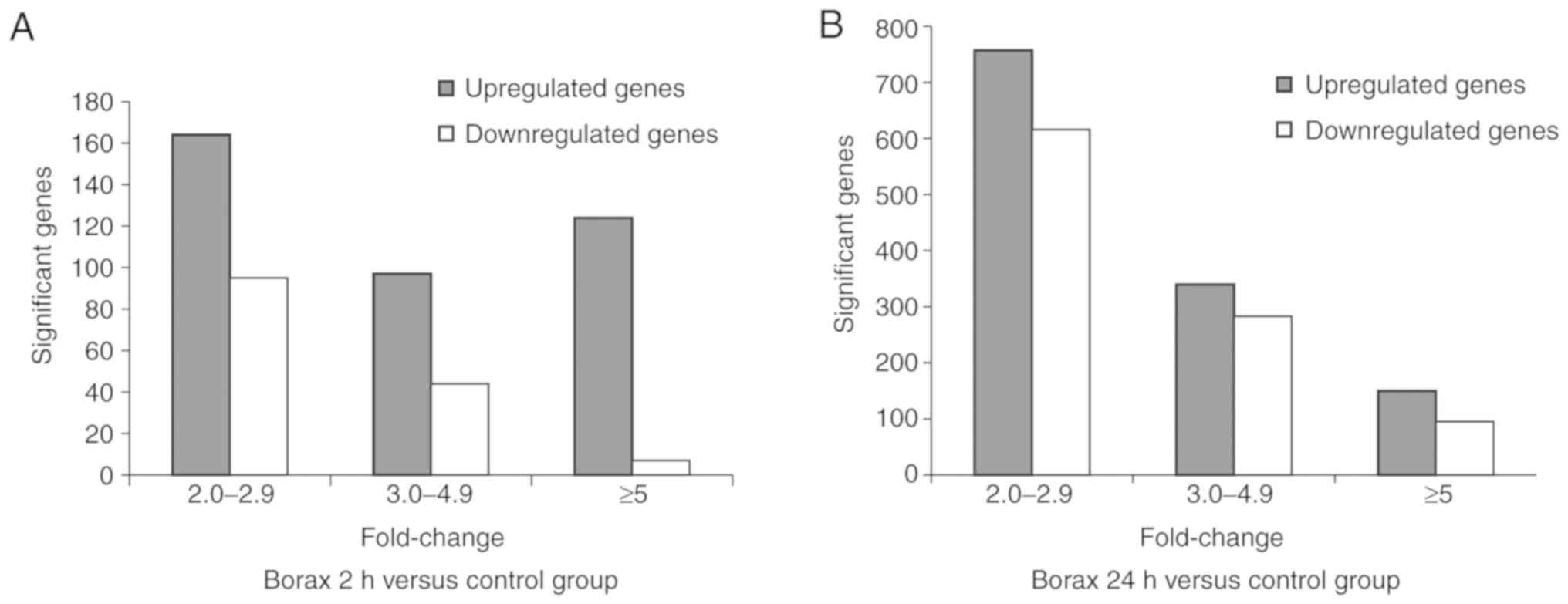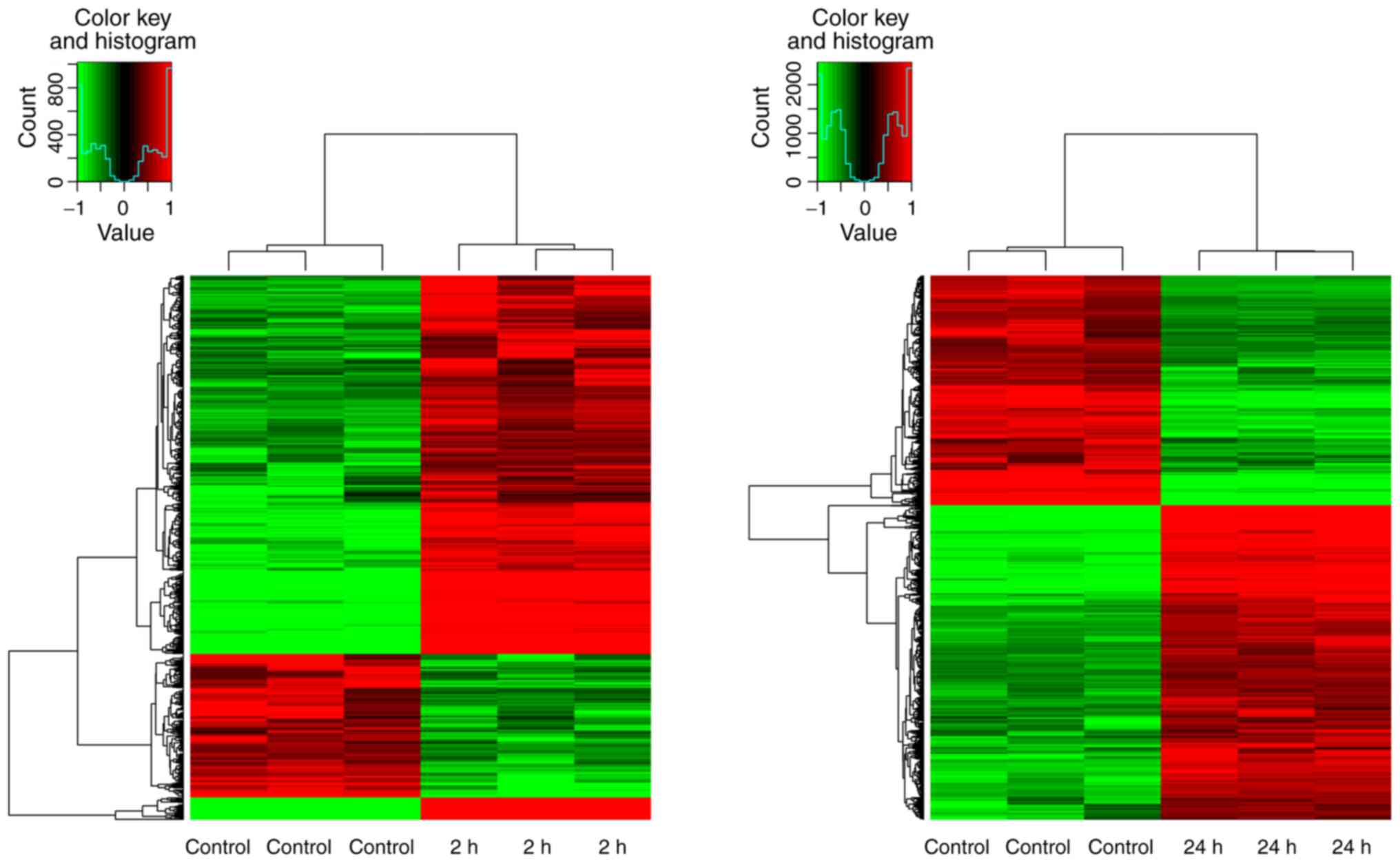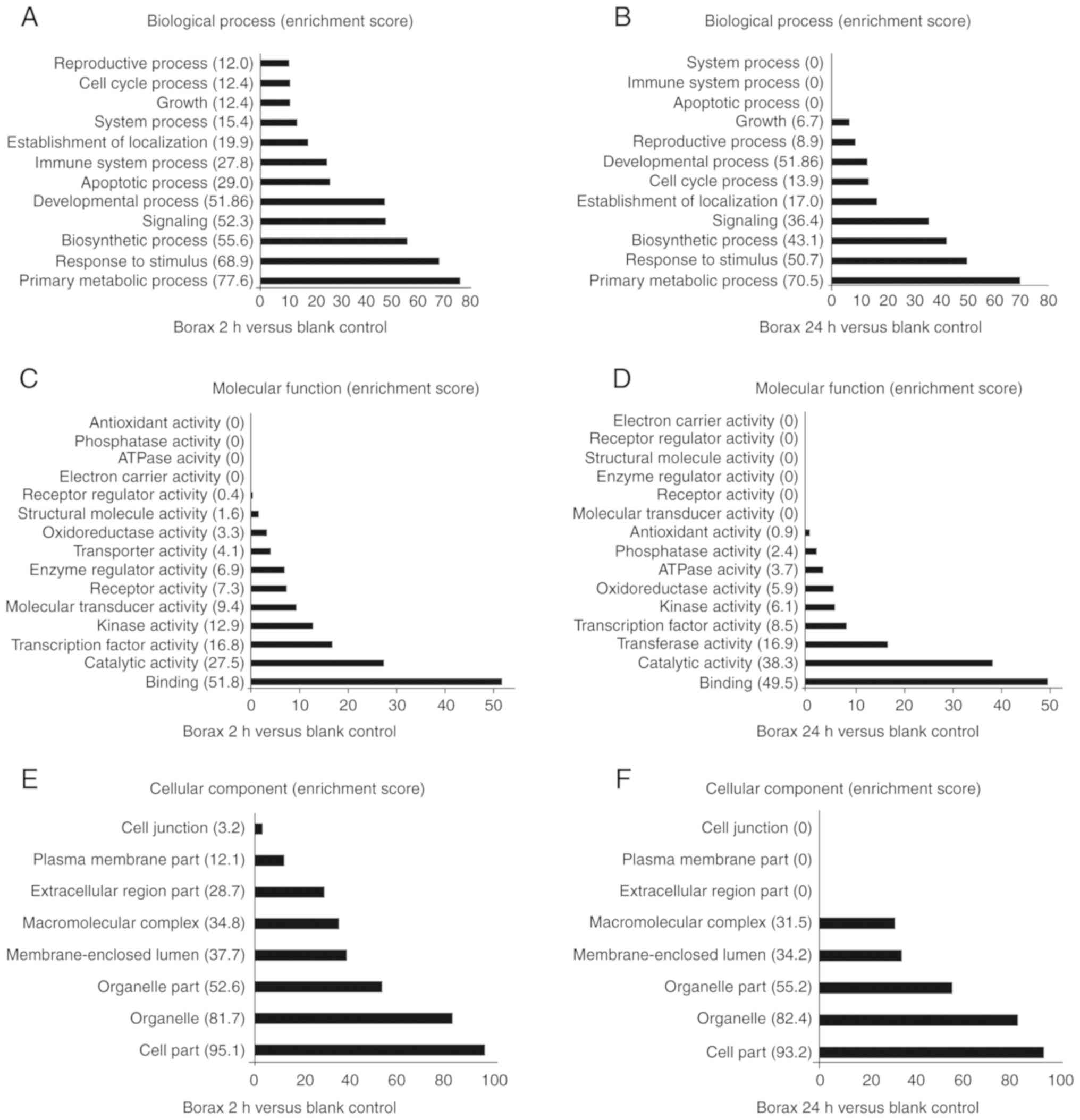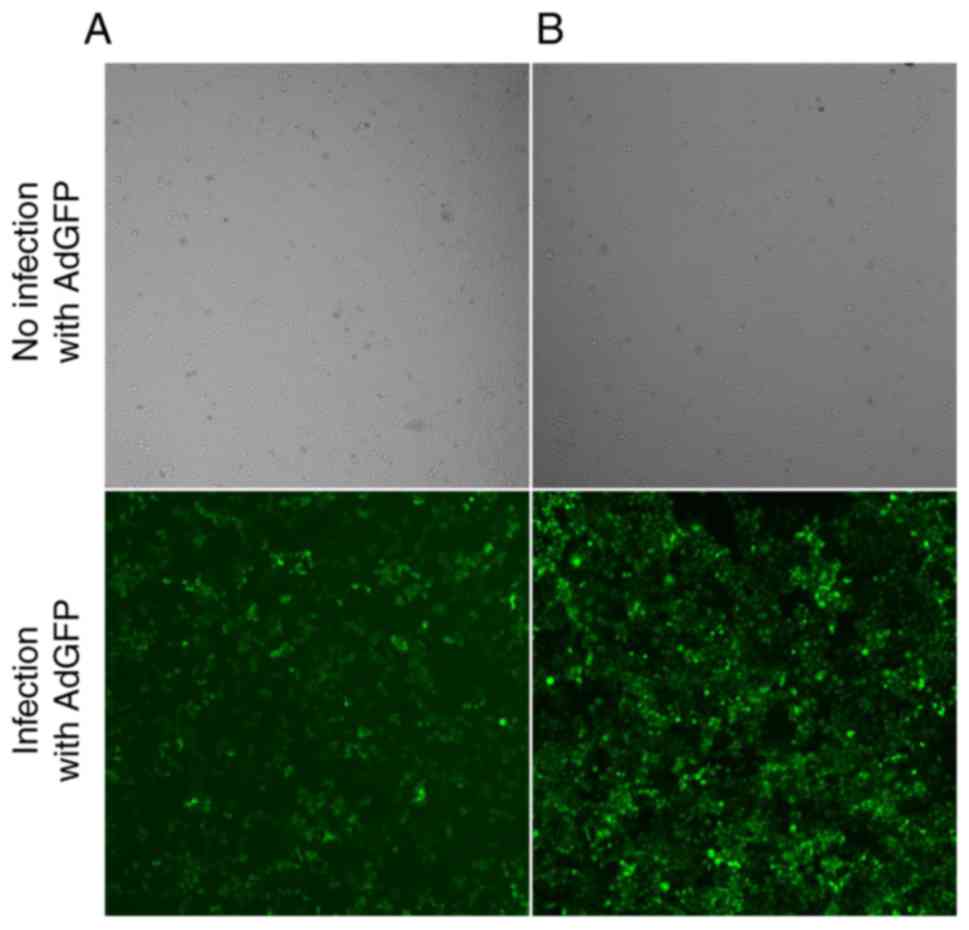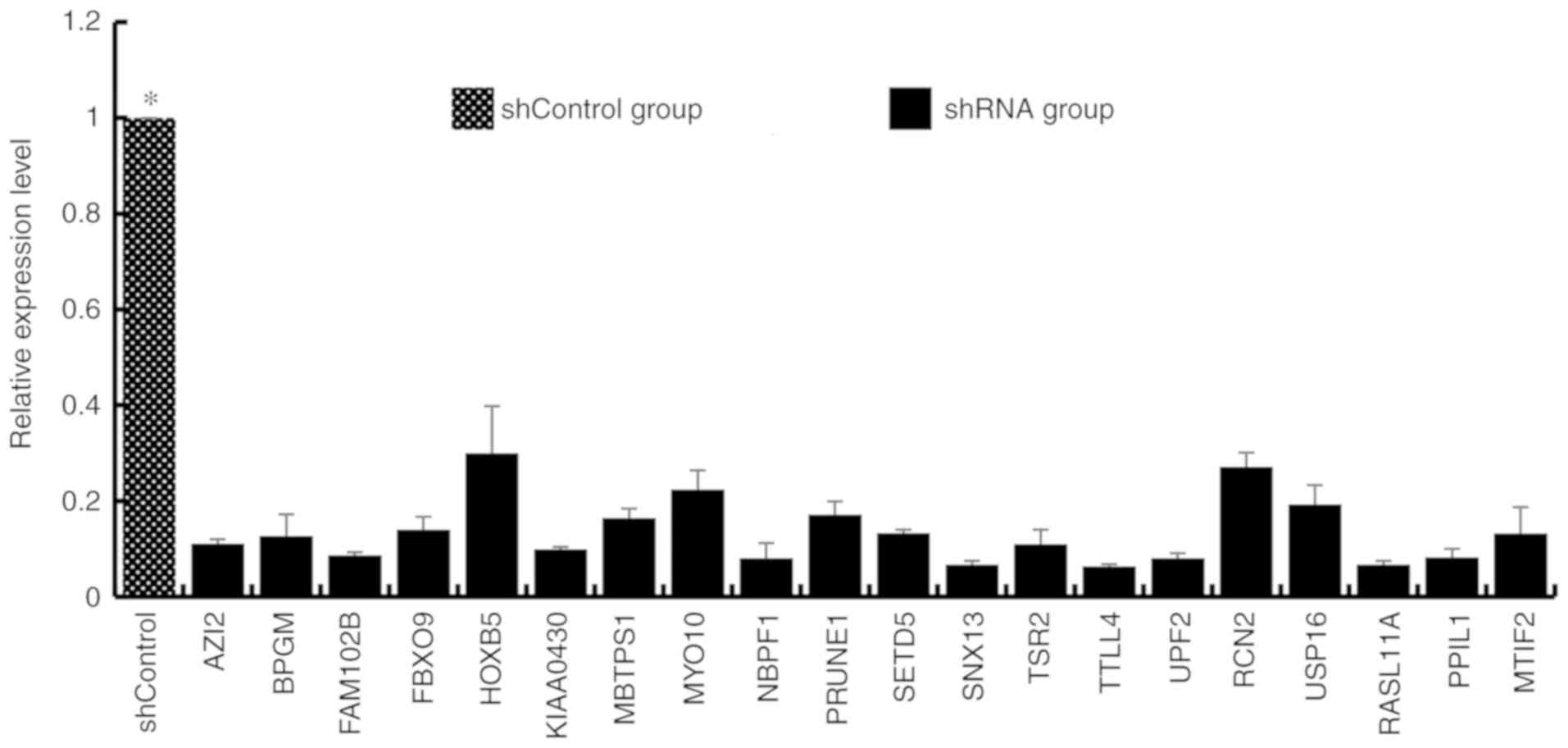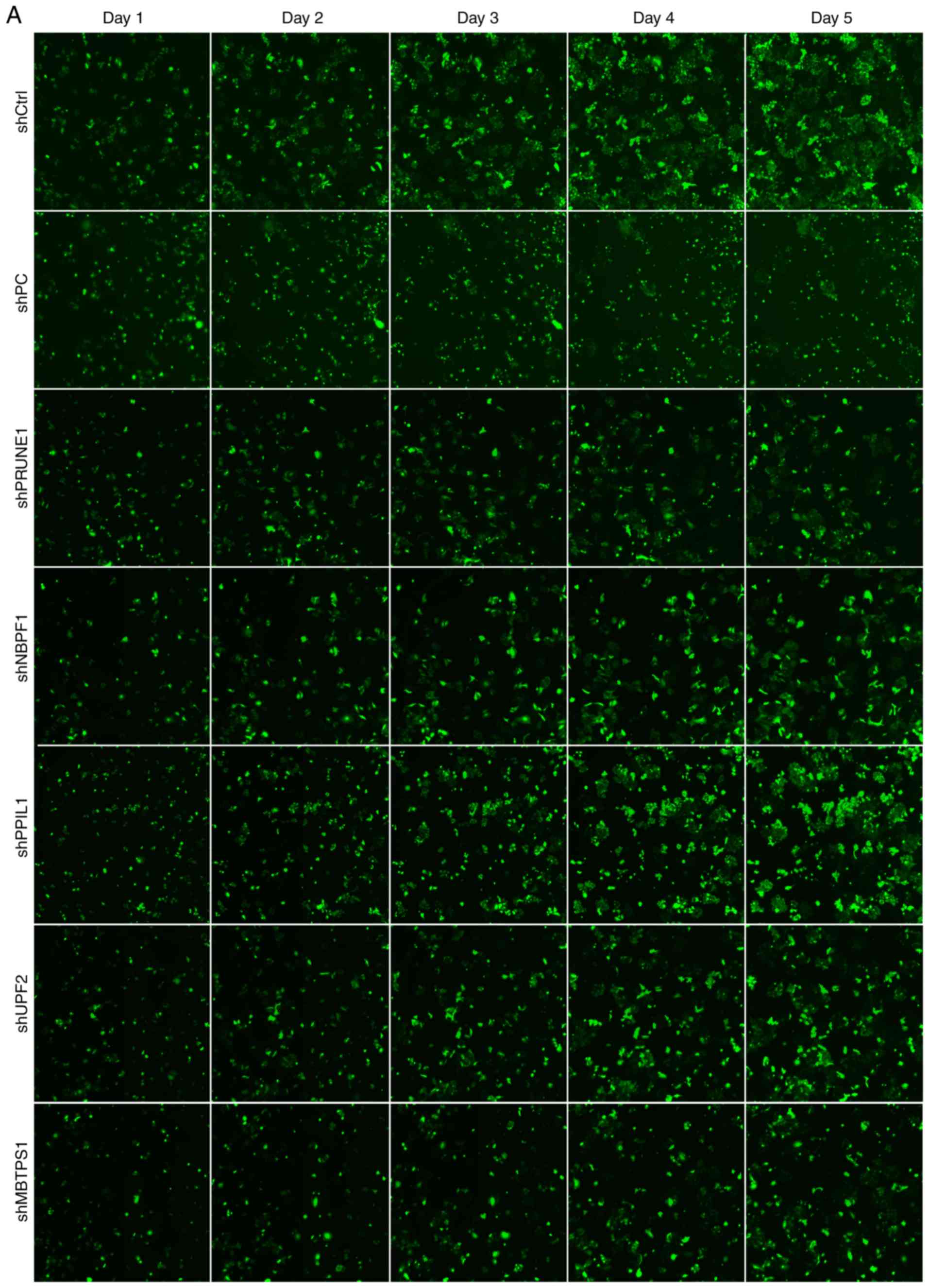|
1
|
Routray I and Ali S: Boron induces
lymphocyte proliferation and modulates the priming effects of
lipopolysaccharide on macrophages. PLoS One. 11:e01506072016.
View Article : Google Scholar : PubMed/NCBI
|
|
2
|
Neiner D, Sevryugina YV, Harrower LS and
Schubert DM: Structure and properties of sodium enneaborate,
Na2[B8O11(OH)4]·B(OH)3·2H2O.
Inorg Chem. 56:7175–7181. 2017. View Article : Google Scholar : PubMed/NCBI
|
|
3
|
Alak G, Parlak V, Yeltekin AÇ, Ucar A,
Çomaklı S, Topal A, Atamanalp M, Özkaraca M and Türkez H: The
protective effect exerted by dietary borax on toxicity metabolism
in rainbow trout (Oncorhynchus mykiss) tissues. Comp Biochem
Physiol C Toxicol Pharmacol. 216:82–92. 2019. View Article : Google Scholar : PubMed/NCBI
|
|
4
|
Alak G, Parlak V, Aslan ME, Ucar A,
Atamanalp M and Turkez H: Borax supplementation alleviates
hematotoxicity and DNA damage in rainbow trout (Oncorhynchus
mykiss) exposed to copper. Biol Trace Elem Res. 187:536–542. 2019.
View Article : Google Scholar : PubMed/NCBI
|
|
5
|
Hussain SA, Abood SJ and Gorial FI: The
adjuvant use of calcium fructoborate and borax with etanercept in
patients with rheumatoid arthritis: Pilot study. J Intercult
Ethnopharmacol. 6:58–64. 2016. View Article : Google Scholar : PubMed/NCBI
|
|
6
|
Ince S, Kucukkurt I, Cigerci IH, Fatih
Fidan A and Eryavuz A: The effects of dietary boric acid and borax
supplementation on lipid peroxidation, antioxidant activity, and
DNA damage in rats. J Trace Elem Med Biol. 24:161–164. 2010.
View Article : Google Scholar : PubMed/NCBI
|
|
7
|
Sandeep Varma R, Shamsia S, Thiyagarajan
OS, Vidyashankar S and Patki PS: Yashada bhasma (Zinc calx) and
Tankana (Borax) inhibit Propionibacterium acne and suppresses acne
induced inflammation in vitro. Int J Cosmet Sci. 36:361–368. 2014.
View Article : Google Scholar : PubMed/NCBI
|
|
8
|
López-Cabrera Y, Castillo-García EL,
Altamirano-Espino JA, Pérez-Capistran T, Farfán-García ED,
Trujillo-Ferrara JG and Soriano-Ursúa MA: Profile of three
boron-containing compounds on the body weight, metabolism and
inflammatory markers of diabetic rats. J Trace Elem Med Biol.
50:424–429. 2018. View Article : Google Scholar : PubMed/NCBI
|
|
9
|
Geyikoglu F and Turkez H: Boron compounds
reduce vanadium tetraoxide genotoxicity in human lymphocytes.
Environ Toxicol Pharmacol. 26:342–347. 2008. View Article : Google Scholar : PubMed/NCBI
|
|
10
|
Gülsoy N, Yavas C and Mutlu Ö: Genotoxic
effects of boric acid and borax in zebrafish, Danio rerio using
alkaline comet assay. EXCLI J. 14:890–899. 2015.PubMed/NCBI
|
|
11
|
Sarkar PK, Prajapati PK, Shukla VJ and
Ravishankar B: Evaluation of processed borax as antidote for
aconite poisoning. J Ethnopharmacol. 205:138–146. 2017. View Article : Google Scholar : PubMed/NCBI
|
|
12
|
Capkin E, Ozcelep T, Kayis S and Altinok
I: Antimicrobial agents, triclosan, chloroxylenol,
methylisothiazolinone and borax, used in cleaning had genotoxic and
histopathologic effects on rainbow trout. Chemosphere. 182:720–729.
2017. View Article : Google Scholar : PubMed/NCBI
|
|
13
|
Pongsavee M: Genotoxic effects of borax on
cultured lymphocytes. Southeast Asian J Trop Med Public Health.
40:411–418. 2009.PubMed/NCBI
|
|
14
|
Pongsavee M: Effect of borax on immune
cell proliferation and sister chromatid exchange in human
chromosomes. J Occup Med Toxicol. 4:272009. View Article : Google Scholar : PubMed/NCBI
|
|
15
|
Çelikezen FÇ, Toğar B, Özgeriş FB, İzgi MS
and Türkez H: Cytogenetic and oxidative alterations after exposure
of cultured human whole blood cells to lithium metaborate
dehydrate. Cytotechnology. 68:821–827. 2016. View Article : Google Scholar : PubMed/NCBI
|
|
16
|
Wei Y, Yuan FJ, Zhou WB, Wu L, Chen L,
Wang JJ and Zhang YS: Borax-induced apoptosis in HepG2 cells
involves p53, Bcl-2, and Bax. Genet Mol Res. 15:2016. View Article : Google Scholar :
|
|
17
|
Brocato J and Costa M: Basic mechanics of
DNA methylation and the unique landscape of the DNA methylome in
metal-induced carcinogenesis. Crit Rev Toxicol. 43:493–514. 2013.
View Article : Google Scholar : PubMed/NCBI
|
|
18
|
Hazman Ö, Bozkurt MF, Fidan AF, Uysal FE
and Çelik S: the effect of boric acid and borax on oxidative
stress, inflammation, ER stress and apoptosis in cisplatin
toxication and nephrotoxicity developing as a result of toxication.
Inflammation. 41:1032–1048. 2018. View Article : Google Scholar : PubMed/NCBI
|
|
19
|
Oh SH and Lim SC: A rapid and transient
ROS generation by cadmium triggers apoptosis via caspase-dependent
pathway in HepG2 cells and this is inhibited through
N-acetylcysteine-mediated catalase upregulation. Toxicol Appl
Pharmacol. 212:212–223. 2006. View Article : Google Scholar : PubMed/NCBI
|
|
20
|
Cartularo L, Laulicht F, Sun H, Kluz T,
Freedman JH and Costa M: Gene expression and pathway analysis of
human hepatocellular carcinoma cells treated with cadmium. Toxicol
Appl Pharmacol. 288:399–408. 2015. View Article : Google Scholar : PubMed/NCBI
|
|
21
|
Livak KJ and Schmittgen TD: Analysis of
relative gene expression data using real-time quantitative PCR and
the 2(-Delta Delta C(T)) method. Methods. 25:402–408. 2001.
View Article : Google Scholar : PubMed/NCBI
|
|
22
|
Zhang DY, Liu Z, Lu Z, Sun WL, Ma X, Zhang
P, Wu BQ and Cui PY: Lentivirus-mediated overexpression of HSDL2
suppresses cell proliferation and induces apoptosis in
cholangiocarcinoma. Onco Targets Ther. 11:7133–7142. 2018.
View Article : Google Scholar : PubMed/NCBI
|
|
23
|
Zheng J, You W, Zheng C, Wan P, Chen J,
Jiang X, Zhu Z, Zhang Z, Gong A, Li W, et al: Knockdown of FBXO39
inhibits proliferation and promotes apoptosis of human osteosarcoma
U-2OS cells. Oncol Lett. 16:1849–1854. 2018.PubMed/NCBI
|
|
24
|
Yamada KE and Eckhert CD: Boric acid
activation of eIF2α and Nrf2 Is PERK dependent: A mechanism that
explains how boron prevents DNA damage and enhances antioxidant
status. Biol Trace Elem Res. 188:2–10. 2019. View Article : Google Scholar : PubMed/NCBI
|
|
25
|
Matencio A, Navarro-Orcajada S,
García-Carmona F and López-Nicolás JM: Ellagic acid-borax
fluorescence interaction: Application for novel cyclodextrin-borax
nanosensors for analyzing ellagic acid in food samples. Food Funct.
9:3683–3687. 2018. View Article : Google Scholar : PubMed/NCBI
|
|
26
|
Donoiu I, Militaru C, Obleagă O, Hunter
JM, Neamţu J, Biţă A, Scorei IR and Rogoveanu OC: Effects of
boron-containing compounds on cardiovascular disease risk factors-a
review. J Trace Elem Med Biol. 50:47–56. 2018. View Article : Google Scholar : PubMed/NCBI
|
|
27
|
Worm DJ, Els-Heindl S, Kellert M, Kuhnert
R, Saretz S, Koebberling J, Riedl B, Hey-Hawkins E and
Beck-Sickinger AG: A stable meta-carborane enables the generation
of boron-rich peptide agonists targeting the ghrelin receptor. J
Pept Sci. 24:e31192018. View Article : Google Scholar : PubMed/NCBI
|
|
28
|
Rico P, Rodrigo-Navarro A and
Salmerón-Sánchez M: Borax-Loaded PLLA for promotion of myogenic
differentiation. Tissue Eng Part A. 21:2662–2672. 2015. View Article : Google Scholar : PubMed/NCBI
|
|
29
|
Das BC, Thapa P, Karki R, Schinke C, Das
S, Kambhampati S, Banerjee SK, Van Veldhuizen P, Verma A, Weiss LM
and Evans T: Boron chemicals in diagnosis and therapeutics. Future
Med Chem. 5:653–676. 2013. View Article : Google Scholar : PubMed/NCBI
|
|
30
|
Turkez H: Effects of boric acid and borax
on titanium dioxide genotoxicity. J Appl Toxicol. 28:658–664. 2008.
View Article : Google Scholar : PubMed/NCBI
|
|
31
|
Jensen JP: The rise and fall of borax as
an antiepileptic drug. Arch Neurol. 63:621–622. 2006. View Article : Google Scholar : PubMed/NCBI
|
|
32
|
Meyer-Hamme G, Beckmann K, Radtke J,
Efferth T, Greten HJ, Rostock M and Schröder S: A survey of chinese
medicinal herbal treatment for chemotherapy-induced oral mucositis.
Evid Based Complement Alternat Med. 2013:2849592013. View Article : Google Scholar : PubMed/NCBI
|
|
33
|
Landolph JR: Cytotoxicity and negligible
genotoxicity of borax and borax ores to cultured mammalian cells.
Am J Ind Med. 7:31–43. 1985. View Article : Google Scholar : PubMed/NCBI
|
|
34
|
Chen CP, Sun ZL, Lu X, Wu WX, Guo WL, Lu
JJ, Han C, Huang JQ and Fang Y: MiR-340 suppresses cell migration
and invasion by targeting MYO10 in breast cancer. Oncol Rep.
35:709–716. 2016. View Article : Google Scholar : PubMed/NCBI
|
|
35
|
Makowska KA, Hughes RE, White KJ, Wells CM
and Peckham M: Specific myosins control actin organization, cell
morphology, and migration in prostate cancer cells. Cell Rep.
13:2118–2125. 2015. View Article : Google Scholar : PubMed/NCBI
|
|
36
|
Zhang H, He P, Huang R, Sun L, Liu S, Zhou
J, Guo Y, Yang D and Xie P: Identification and bioinformatic
analysis of dysregulated microRNAs in human oligodendroglial cells
infected with borna disease virus. Mol Med Rep. 14:4715–4722. 2016.
View Article : Google Scholar : PubMed/NCBI
|
|
37
|
Pinto JA, Rolfo C, Raez LE, Prado A,
Araujo JM, Bravo L, Fajardo W, Morante ZD, Aguilar A, Neciosup SP,
et al: In silico evaluation of DNA Damage Inducible Transcript 4
gene (DDIT4) as prognostic biomarker in several malignancies. Sci
Rep. 7:15262017. View Article : Google Scholar : PubMed/NCBI
|
|
38
|
Shatov VM, Weeks SD, Strelkov SV and Gusev
NB: The role of the arginine in the conserved N-terminal domain
RLFDQxFG motif of human small heat shock proteins HspB1, HspB4,
HspB5, HspB6, and HspB8. Int J Mol Sci. 19(pii): E21122018.
View Article : Google Scholar : PubMed/NCBI
|
|
39
|
Konda JD, Olivero M, Musiani D, Lamba S
and Di Renzo MF: Heat-shock protein 27 (HSP27, HSPB1) is synthetic
lethal to cells with oncogenic activation of MET, EGFR and BRAF.
Mol Oncol. 11:599–611. 2017. View Article : Google Scholar : PubMed/NCBI
|
|
40
|
Mohamad T, Kazim N, Adhikari A and Davie
JK: EGR1 interacts with TBX2 and functions as a tumor suppressor in
rhabdomyosarcoma. Oncotarget. 9:18084–18098. 2018. View Article : Google Scholar : PubMed/NCBI
|
|
41
|
Li H, Wang J, Liu X and Cheng Q:
MicroRNA-204-5p suppresses caspase-6-mediated inflammatory response
and chemokine generation in HK-2 renal tubular epithelial cells by
targeting caspase-6R. Biochem Cell Biol. 97:109–117. 2019.
View Article : Google Scholar : PubMed/NCBI
|
|
42
|
Zhai Y, Lin P, Feng Z, Lu H, Han Q, Chen
J, Zhang Y, He Q, Nan G, Luo X, et al: TNFAIP3-DEPTOR complex
regulates inflammasome secretion through autophagy in ankylosing
spondylitis monocytes. Autophagy. 14:1629–1643. 2018. View Article : Google Scholar : PubMed/NCBI
|
|
43
|
Pinna F, Bissinger M, Beuke K, Huber N,
Longerich T, Kummer U, Schirmacher P, Sahle S and Breuhahn K:
A20/TNFAIP3 discriminates tumor necrosis factor (TNF)-Induced NF-κB
from JNK pathway activation in hepatocytes. Front Physiol.
8:6102017. View Article : Google Scholar : PubMed/NCBI
|
|
44
|
Wen J, Xiao J, Rahdar M, Choudhury BP, Cui
J, Taylor GS, Esko JD and Dixon JE: Xylose phosphorylation
functions as a molecular switch to regulate proteoglycan
biosynthesis. Proc Natl Acad Sci USA. 111:15723–15728. 2014.
View Article : Google Scholar : PubMed/NCBI
|
|
45
|
Taylan F and Mäkitie O: Abnormal
proteoglycan synthesis due to gene defects causes skeletal diseases
with overlapping phenotypes. Horm Metab Res. 48:745–754. 2016.
View Article : Google Scholar : PubMed/NCBI
|
|
46
|
Van Damme T, Pang X, Guillemyn B, Gulberti
S, Syx D, De Rycke R, Kaye O, de Die-Smulders CEM, Pfundt R,
Kariminejad A, et al: Biallelic B3GALT6 mutations cause
spondylodysplastic Ehlers-Danlos syndrome. Hum Mol Genet.
27:3475–3487. 2018. View Article : Google Scholar : PubMed/NCBI
|
|
47
|
Zhang XF, Pan QZ, Pan K, Weng DS, Wang QJ,
Zhao JJ, He J, Liu Q, Wang DD, Jiang SS, et al: Expression and
prognostic role of ubiquitination factor E4B in primary
hepatocellular carcinoma. Mol Carcinog. 55:64–76. 2016. View Article : Google Scholar : PubMed/NCBI
|
|
48
|
Periz G, Lu J, Zhang T, Kankel MW,
Jablonski AM, Kalb R, McCampbell A and Wang J: Regulation of
protein quality control by UBE4B and LSD1 through p53-mediated
transcription. PLoS Biol. 13:e10021142015. View Article : Google Scholar : PubMed/NCBI
|
|
49
|
Wang B, Wu H, Chai C, Lewis J, Pichiorri
F, Eisenstat DD, Pomeroy SL and Leng RP: MicroRNA-1301 suppresses
tumor cell migration and invasion by targeting the p53/UBE4B
pathway in multiple human cancer cells. Cancer Lett. 401:20–32.
2017. View Article : Google Scholar : PubMed/NCBI
|
|
50
|
Okano T: A new horizon in vitamin K
research. Yakugaku Zasshi. 136:1141–1159. 2016.(In Japanese).
View Article : Google Scholar : PubMed/NCBI
|
|
51
|
Li L, Wang W, Li X and Gao T: Association
of ECRG4 with PLK1, CDK4, PLOD1 and PLOD2 in esophageal squamous
cell carcinoma. Am J Transl Res. 9:3741–3748. 2017.PubMed/NCBI
|
|
52
|
Rosati M, Rocchi M, Storlazzi CT and
Grimaldi G: Assignment to chromosome 12q24.33, gene organization
and splicing of the human KRAB/FPB containing zinc finger gene
ZNF84. Cytogenet Cell Genet. 94:127–130. 2001. View Article : Google Scholar : PubMed/NCBI
|
|
53
|
Assou S, Cerecedo D, Tondeur S, Pantesco
V, Hovatta O, Klein B, Hamamah S and De Vos J: A gene expression
signature shared by human mature oocytes and embryonic stem cells.
BMC Genomics. 10:102009. View Article : Google Scholar : PubMed/NCBI
|
|
54
|
Zhou Q, Hahn JK, Neupane B, Aidery P,
Labeit S, Gawaz M and Gramlich M: Dysregulated ier3 expression is
associated with enhanced apoptosis in titin-based dilated
cardiomyopathy. Int J Mol Sci. 18(pii): E7232017. View Article : Google Scholar : PubMed/NCBI
|
|
55
|
Tran DDH, Koch A, Allister A, Saran S,
Ewald F, Koch M, Nashan B and Tamura T: Treatment with MAPKAP2
(MK2) inhibitor and DNA methylation inhibitor, 5-aza dC,
synergistically triggers apoptosis in hepatocellular carcinoma
(HCC) via tristetraprolin (TTP). Cell Signal. 28:1872–1880. 2016.
View Article : Google Scholar : PubMed/NCBI
|
|
56
|
Mathew S, Abdel-Hafiz H, Raza A, Fatima K
and Qadri I: Host nucleotide polymorphism in hepatitis B
virus-associated hepatocellular carcinoma. World J Hepatol.
8:485–498. 2016. View Article : Google Scholar : PubMed/NCBI
|
|
57
|
Zollo M, Ahmed M, Ferrucci V, Salpietro V,
Asadzadeh F, Carotenuto M, Maroofian R, Al-Amri A, Singh R,
Scognamiglio I, et al: PRUNE is crucial for normal brain
development and mutated in microcephaly with neurodevelopmental
impairment. Brain. 140:940–952. 2017. View Article : Google Scholar : PubMed/NCBI
|
|
58
|
Li D, Li P, Wu J, Yi J, Dou Y, Guo X, Yin
Y, Wang D, Ma C and Qiu L: Methylation of NBPF1 as a novel marker
for the detection of plasma cell-free DNA of breast cancer
patients. Clin Chim Acta. 484:81–86. 2018. View Article : Google Scholar : PubMed/NCBI
|
|
59
|
Andries V, Vandepoele K, Staes K, Berx G,
Bogaert P, Van Isterdael G, Ginneberge D, Parthoens E,
Vandenbussche J, Gevaert K and van Roy F: NBPF1, a tumor suppressor
candidate in neuroblastoma, exerts growth inhibitory effects by
inducing a G1 cell cycle arrest. BMC Cancer. 15:3912015. View Article : Google Scholar : PubMed/NCBI
|
|
60
|
Stegmann CM, Lührmann R and Wahl MC: The
crystal structure of PPcaspase-1 bound to cyclosporine A suggests a
binding mode for a linear epitope of the SKIP protein. PLoS One.
5:e100132010. View Article : Google Scholar : PubMed/NCBI
|















